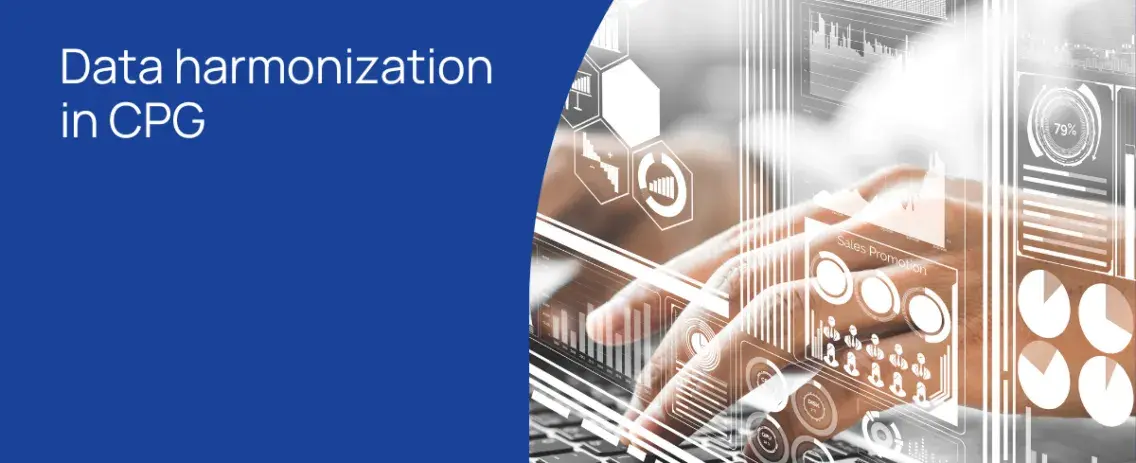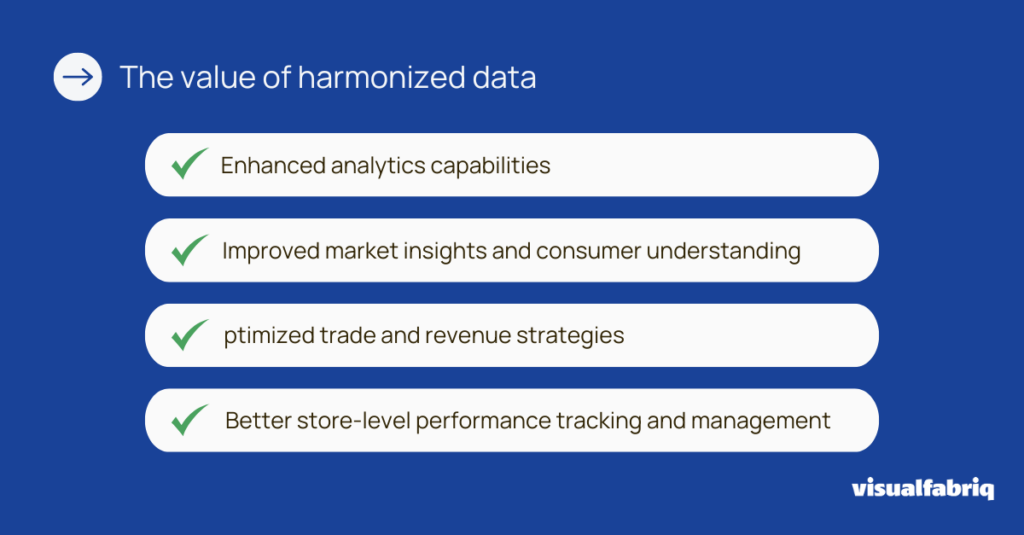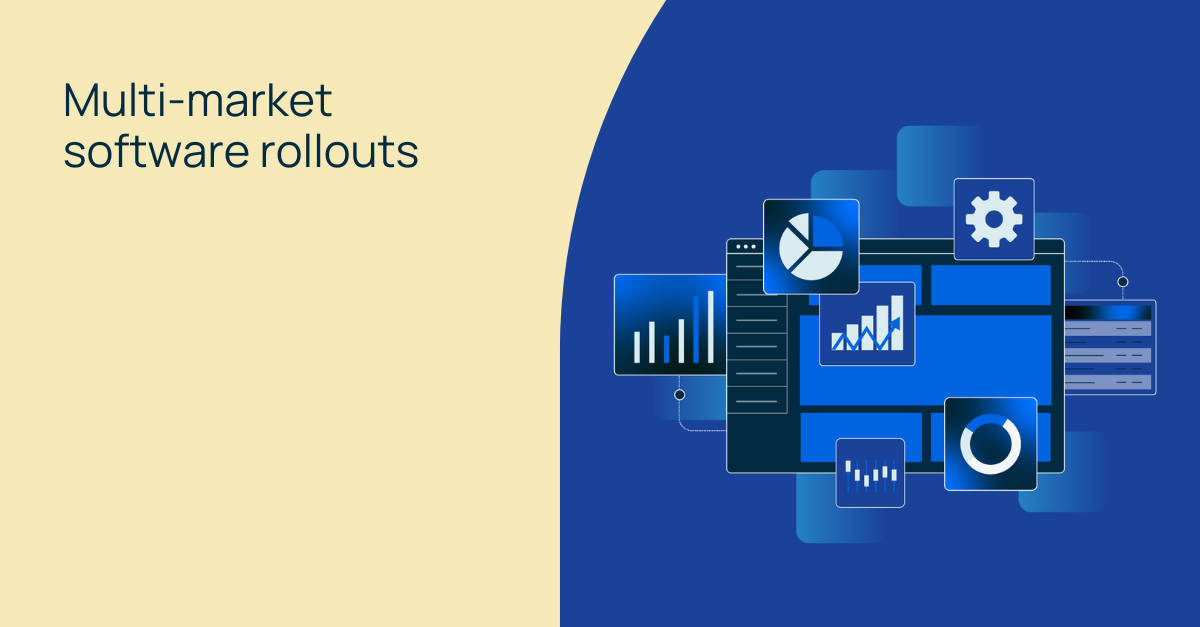
Enhancing CPG analytics: the role of data harmonization
Data and analytics are a big deal in the consumer-packaged goods (CPG) industry. It tells us what’s selling, what’s not, and what we can do to keep our customers happy. But with so much different data coming from various places, it can be hard to stitch together and make sense of it all. That’s why data harmonization is essential for CPG analytics. Harmonizing data enhances the quality, precision, and usefulness of CPG data. It’s like a translator for data, making sure that all the data is cleansed, standardized, and ready for analysis. This process is key to providing a complete and unified view, keeping everyone informed and aligned.
Why data integration and harmonization is vitally important for CPG analytics
In this article, we’re going to talk about why data harmonization is essential for CPG analytics. We’ll not only look at what it is but also why it’s important. In addition, we’ll discuss how it can make a substantial difference in the way we make decisions and plan for the future.
40% of CPG organizations state that proper data cleansing, harmonizing, and staging the data is holding them back from delivering trade promotion optimization and analytics — Promotion Optimization Institute (POI) 2025 State of the Industry report
So, if you’ve ever wondered how to make your data work harder for you, stay tuned. Because we’re about to dive into the world of CPG data harmonization and discover how it can help your business get ahead.
What is retail CPG data harmonization?
Data harmonization is a crucial step for enabling CPG analytics, making sure that data from various sources such as ex-factory, retail EPoS, and syndicated data can work together seamlessly. Imagine you have a puzzle, but the pieces come from different sets. They’re all different shapes and sizes, and they don’t fit together. Data harmonization is like finding the right pieces that fit perfectly, creating a clear picture.
Here’s what happens during retail CPG data harmonization:

- Integration: Bringing together disparate data from various sources, both internal and external. This could be sell-in from one source, sell-out from another (retail direct data such as ePOS, or syndicated data from providers like Nielsen and Circana), and market trends from a third source.
- Cleansing: data scrubbing removes inaccuracies, duplicates, and irrelevant data to ensure quality. Just like you’d get rid of any puzzle pieces that don’t belong.
- Standardization: We then make sure that all this data speaks the same language. This means aligning formats, units of measurement, and naming conventions so that everything is consistent.
- Unified schema: After standardizing, we organize the data into a unified structure. This is like sorting the puzzle pieces into corners, edges, and middle pieces so you know where everything goes.
- ‘Analysis-ready’ dataset: Finally, we have a dataset that’s clean, organized, and ready for analysis. This is your completed puzzle, giving you a cohesive, full picture.
What’s the link with data management?
Now that we’ve established what data harmonization is, let’s see how it fits within the broader context of data integration and data management in CPG.
As we’ve discussed, data harmonization is a critical component of data management. Because it ensures that the data from various sources is not only brought together but also made consistent and standardized for effective use. While data integration focuses on the initial collection and combination of data, data management encompasses the entire governance, organization, and utilization of data assets. Data harmonization bridges these two areas, enhancing the quality and usability of the data.
To clarify:
- Data integration: This is the first step in the data management process. At this stage, we’re collecting and combining data from diverse sources. Think of it as gathering all the ingredients you need to cook a meal. You’re bringing together vegetables, meats, spices, and so on from various places into one kitchen.
- Data management: This is the overarching process that includes all aspects of handling data, much like managing the entire process of preparing, cooking, and serving the meal. It involves data integration, data quality, data governance, and data storage. It’s about having systems and policies in place to handle data efficiently and securely throughout its lifecycle.
- Data harmonization: This is a subset of data management and a step further from data integration. Once the data is integrated, data harmonization ensures that the data is not just mixed together but is also standardized and consistent. It’s like making sure all the ingredients are prepped in a way that they cook evenly and taste harmonious in the final dish.
By understanding these concepts, we can appreciate the intricate process that ensures data is not just collected but also crafted into a valuable asset for business intelligence and decision-making.
-1.png?width=824&height=206&name=the%20CPG%20Executive%E2%80%99s%20Guide%20to%20Strategic%20RGM%20(3)-1.png)
What data sources need to be harmonized?
In the CPG industry, data harmonization involves integrating and standardizing a variety of data sources to create a comprehensive view of the business landscape. Here are some examples of common data sources:
- Market performance data: This includes sales figures, market share statistics, and competitive analysis reports. It provides insights into how products are performing in the market and how they stack up against competitors. This data is typically used for mathematical and statistical analysis.
- Store-level information: This involves data from retail locations, such as sales by SKU. It’s vital for optimizing product distribution and in-store marketing efforts. Like market performance data, store-level information is typically used for mathematical and statistical analysis, often combined with ex-factory data.
- Consumer research data: This encompasses customer surveys, feedback forms, and product reviews. It helps in understanding consumer preferences, behaviors, and trends. This data usually serves to predict long-term trends.
- Trade and revenue trends: This data covers information on trade promotions, pricing strategies, and revenue outcomes. It’s crucial for evaluating sales strategies and trade promotion effectiveness. Like consumer research data, it is often used to predict long-term trends.
By combining and harmonizing data from various sources, CPG companies can gain a holistic view of their operations, consumer sentiments, and market dynamics. This enables them to make data-driven decisions that enhance performance and profitability.
Data harmonization: critical for RGM analytics in CPG
The importance of data harmonization in the CPG industry can hardly be overstated. It ensures that data across the organization is consistent and accurate, which is crucial for maintaining a single source of truth for all data users. This uniformity is key to improving decision-making processes and refining business strategies.
Moreover, data harmonization plays a significant role in enhancing operational efficiency. It eliminates data silos and reduces redundancy. Consequently, CPGs can allocate resources more effectively, and teams can work more cohesively. By providing democratic access to a single window of shared knowledge, everyone can work from the same page. As a result, CPG companies can streamline their operations, leading to better outcomes and a stronger competitive edge in the market.
In summary, data harmonization is a foundational element that supports the integrity and reliability of data-driven insights. It fosters informed strategic planning and robust business growth.
Challenges in harmonizing data
Achieving data harmonization in the CPG industry presents several challenges that organizations must navigate:
- Handling disparate data sources and formats: CPG companies often deal with a wide array of data sources, each with its own format. Harmonizing this data requires robust systems that can process and translate different data types into a unified format.
- Aligning different naming conventions and schemas: Each data source may use its own naming conventions and schemas. Aligning these to ensure consistency across the board is a meticulous task that requires attention to detail and a deep understanding of the data.
- Overcoming data silos within the organization: Data silos occur when different departments or groups within a company store their data separately. Breaking down these silos is essential for data harmonization, as it allows for the free flow and consolidation of information.
- Ensuring data quality and consistency: The quality of data is paramount. Therefore, organizations must implement stringent quality control measures to ensure that the data being harmonized is accurate, complete, and consistent.
These challenges underscore the need for a strategic approach to data harmonization. One that involves the right technology, processes, and governance to ensure success.
Benefits of harmonized data

Harmonized data brings a multitude of benefits to CPG data analytics, significantly enhancing the capabilities and outcomes of analytical efforts:
- Enhanced analytics capabilities. With consistent and comprehensive data, analytics tools can perform more effectively, leading to deeper insights and more accurate predictions.
- Improved market insights and consumer understanding. A harmonized dataset allows for a better understanding of market trends and consumer behaviors. Consequently, it enables CPG companies to tailor their products and marketing strategies more effectively.
- Optimized trade and revenue strategies. By analyzing harmonized data, companies can fine-tune their trade promotions and revenue management strategies to maximize profitability.
- Better store-level performance tracking and management. Harmonized data provides a clearer picture of store-level performance. Therefore, it aids in inventory management, staffing decisions, and in-store marketing initiatives.
Overall, the benefits of harmonized data for CPG analytics are clear: it leads to smarter business decisions, more efficient operations, and ultimately, a stronger position in the marketplace.
Check out our on-demand webinar: Understanding and perfecting data to enable RGM
The role of technology in retail CPG data harmonization
Technology plays a pivotal role in data harmonization within the CPG industry. It serves as the backbone that facilitates the integration, transformation, and standardization of diverse data sources. Without the right tools, harmonizing data can be an exhaustive, time-consuming process. But by leveraging advanced software solutions, CPG organizations can streamline the complex process of data harmonization.
By utilizing these technological capabilities, companies can overcome the challenges of disparate data sources and formats, align different naming conventions and schemas, and break down data silos. This not only improves the quality and consistency of CPG data but also enhances the overall analytics capabilities.
Visualfabriq makes CPG analytics easy
Visualfabriq brings a transformative approach to CPG analytics by offering a suite of tools that streamline the data harmonization process. Its cloud software integrates seamlessly with your existing data systems, ensuring that all information is consistent, accurate, and easily accessible. This not only saves time but also provides a solid foundation for advanced analytics and strategic decision-making.
Visualfabriq’s Bifrost data management tool stands at the heart of its analytics solutions, offering unparalleled capabilities in harmonizing and staging the data. This powerful tool ensures that disparate data sources are unified, providing a single source of truth that is both reliable and actionable. Bifrost is built to handle the complexities of data management, automatically updating with new datasets to ensure your analytics are always up-to-date. With this tool, Visualfabriq offers a proactive approach to data harmonization. It enables brands to focus on strategic initiatives rather than the intricacies of data processing.
To truly understand the impact Visualfabriq can have on your CPG data analytics, we invite you to experience a software demo. This hands-on demonstration will allow you to see the platform in action, explore its features, and ask any questions you may have. It’s an opportunity to witness firsthand how Visualfabriq can elevate your data analytics and help you achieve your business objectives.

.png)
.png)
